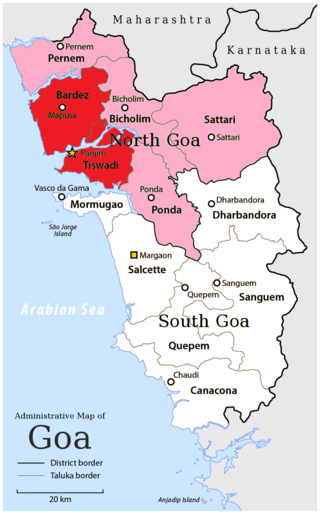Old Goa is a historical site and city situated on the southern banks of the River Mandovi, within the Tiswadi taluka (Ilhas) of North Goa district, in the Indian state of Goa.

Margao is the commercial capital of the Indian state of Goa. It stands on the banks of the river Sal. It is the district headquarters of South Goa, and administrative headquarters of Salcete sub-district. It is Goa's second largest city by population after Mormugao.

North Goa district is one of the two districts that constitutes the state of Goa, India. The district has an area of 1,736 square kilometres, and is bounded by Kolhapur and Sindhudurg districts of Maharashtra state to the north and by Belgavi district of Karnataka to the east, by South Goa district to the south, and by the Arabian Sea to the west.

The Goa Inquisition was an extension of the Portuguese Inquisition in Portuguese India. Its objective was to enforce Catholic orthodoxy and allegiance to the Apostolic See of the Pontifex.

The Basilica of Bom Jesus is a Catholic basilica located in Goa, in the Konkan region of India. The iconic church is a pilgrimage centre and recognised by UNESCO as a World Heritage Site. The basilica is located in Old Goa, the former capital of Portuguese India, and holds the mortal remains of St Francis Xavier.

Mapusa is a city in North Goa, India. It is situated 13 km north of the state capital of Panaji. The city is the headquarters of Bardez taluka. It is located on the main highway NH-17, linking Mumbai to Kochi. During Portuguese India, the city was known as "Mapuçá".

Benaulim (Bannalem) is a village in the state of Goa, India. Located in Salcete taluka of South Goa district, it neighbours Colva village to the north, Margao in the northeast and Varca village to the south. During Portuguese rule, it was one of the nine communidades in Salcete. Benaulim is the birthplace of St Joseph Vaz, who was a priest and missionary in Sri Lanka. Benaulim is home to several traditional carpenters, and has long been known as Goa's 'village of carpenters'. Contemporary Benaulim is a popular seaside resort, renowned for its beautiful rice fields, balmy weather and golden sand beaches. It also houses Goa's only Don Bosco Animation Centre. There are two big churches in Benaulim. The Holy Trinity Church in Mazilvaddo is a modern church built over the centuries-old chapel of the Loiola Pereira family. The St John the Baptist Church in Povacao area closer to Colva, is where St Joseph Vaz was baptised.

Siolim is a village in Bardez taluka, and a census town on the central west coast of India, in the North Goa district of Goa. The 2001 population was 10,311, and 10,936 in 2011. Siolim is also the name of a constituency in the Goa assembly, which includes Assagao, Anjuna and Oxel, in addition to Siolim. A person from Siolim is known as a Siolcar or even as Shivalkar.
Goan Catholics are an ethno-religious community of Indian Christians adhering to the Latin Rite of the Catholic Church from the Goa state, in the southern part of the Konkan region along the west coast of India. They are Konkani people and speak the Konkani language.
Furtado is a surname of Portuguese origin common in Portugal and Brazil. This last name is also found in Goa, India where the Portuguese colonized in the 15th century. It may refer to:
Loutolim or Loutulim is a large village of South Goa district in the state of Goa, India. It is an important settlement in the Salcete sub-district.

Cortalim is a village in Morumugão, Goa, India. Its native Goan population is entirely Catholic and their main occupations include fishing and agriculture. Located on the banks of the Zuari River, it was previously known as Kushasthale.
Raia is a quaint village in the Salcete taluka of South Goa district, Goa state, India. It is located 4 km (2.5 mi) east from the district headquarters of Margao and 35 km (22 mi) from the state capital Panjim.
The United Goans Party is a political party in state of Goa. It was formed in 1963 in the former union territory of Goa, Daman and Diu, with Jack de Sequeira as its party leader, when multiple regional parties merged during the Konkani language agitation.
Captain Alvaro de Loyola Furtado BS WM OM, popularly known as Dr. Alu, was a former member of the Goa, Daman and Diu Legislative Assembly and one of the founding members of the United Goans Party. He was also a social worker, historian, journalist, medical practitioner and humanitarian. Described as a leader among men, a man of great integrity and honour.

The Christian population of Goa are almost entirely Goan Catholics, whose ancestors converted to Christianity during the Portuguese rule in India. Christianisation followed the Portuguese conquest of Goa in 1510, which was followed by the Goa Inquisition from 1560 onwards. The Hindu population is mostly descended from immigrants from other states of India, who have been arriving in Goa since the last century There is a higher proportion of Christians in Velhas Conquistas than in Novas Conquistas.
Mario de Loyola Furtado was a Portuguese lawyer and one of Goa's premier journalists. His family ran a newspaper titled the A India Purtuguesa, which was an avenue for Goans troubled by the Portuguese rule.
The Goan Muslims are a minority community who follow Islam in the Indian coastal state of Goa, some are also present in the union territory of Damaon, Diu & Silvassa. They are native to Goa, unlike recent Muslim migrants from mainland India, and are commonly referred to as Moir by Goans in Goan Konkani.[a]Moir is derived from the Portuguese word Mouro. The Portuguese called them Mouros because they were in contact with the Moors, people of predominantly Muslim Maghreb country, who had conquered and colonised the Iberian peninsula for centuries.
The political parties based in Indian state of Goa













